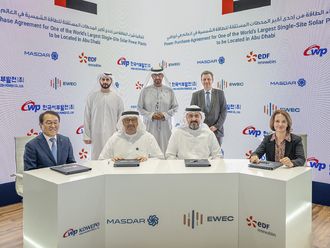Muscat: Petroleum Development Oman, a third owned by Royal Dutch Shell Plc, awarded a contract to GlassPoint Solar Inc to build the Middle East's first solar plant used to generate steam and boost output from ageing oil deposits.
The seven megawatt, four acre site will deploy so-called enhanced oil recovery technology, injecting steam into fields to loosen denser crude, according to an emailed statement yesterday from Fremont, California-based GlassPoint. Previous such operations have burned natural-gas to produce the steam.
Maximising reserves
Arabian Gulf nations, suppliers of about a quarter of the world's oil, are introducing enhanced oil recovery technology to make the most of their reserves. Oman, the biggest Arab oil producer that isn't a member of the Organisation of Petroleum Exporting Countries, has reversed production declines as the country leads the region in its use of the system.
"Over time, the light oil at the top of fields gets used up, so ultimately everyone will be producing heavier and heavier oil," GlassPoint Chief Executive Officer Rod Macgregor said. "Oil producers will need steam from somewhere, so they can either burn gas, which many lack, or they can use solar energy." Saudi Arabia, the biggest crude exporter, will probably use EOR technology for more than 1 million barrels a day of its output by 2030, according to the US Energy Information Administration's World Energy Outlook. Chevron Corp uses steam to produce oil from part of the Wafra field that Kuwait shares with Saudi Arabia. Kuwait plans to produce 60,000 barrels a day of heavy oil by 2016.
While GlassPoint's plant will reduce Oman's use of gas by only 1.6 million cubic metres a year, barely denting the 5.4 billion cubic meters it employs for EOR, "there's no reason you couldn't displace 80 per cent of it," Macgregor said.
Reducing exports
Oman is reducing exports of liquefied natural gas and has delayed building petrochemicals plants in favour of feeding the needs of its own oil production and power plants. At the same time, the country plans to produce 850,000 barrels a day of oil this year, rising to one million barrels in the next five years, Oil Minister Mohammad Al Rumhy said in November.
Crude producers including Saudi Arabia also need gas for power plants as energy demand soars and are seeking alternatives for use in boosting oil output. Both the UAE and Saudi Arabia are considering employing carbon dioxide for EOR.
Abu Dhabi National Oil Co successfully piloted a project using 60 metric tonnes a day of CO2 in the Rumaitha field and is studying an expansion, according to CO2 EOR Strategy Advisor Ganiya Bin Dhaaer Al Yafei.












